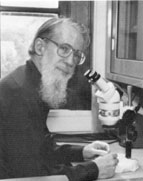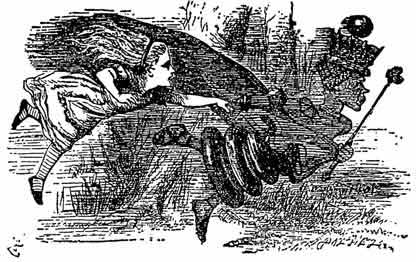Leigh Van Valen Dies
Posted by: Loren Coleman on October 28th, 2010

Evolutionary theorist Leigh Van Valen, PhD, 75, who was on the board of editors for the journal Cryptozoology has died.
Leigh Van Valen, PhD, professor emeritus in the Department of Ecology and Evolution, and a member of the Committees on Evolutionary Biology, Genetics and the Conceptual Foundations of Science at the University of Chicago, died at St. Mary of Nazareth Hospital Center in Chicago on Saturday, October 16, 2010, from a recurrent respiratory infection.

The originator of the influential and widely debated Red Queen hypothesis, Leigh Van Valen, PhD, was 75 years old.
An internationally recognized evolutionary biologist, known for his theoretical studies of extinction and diversification, the evolutionary and ecological role of energy flow in regulating diversity, and the radiation of mammals after the extinction of the dinosaurs, Van Valen was one of the founders of the field of paleobiology, which combines research on current life forms with the study of fossils to answer questions about the processes shaping large-scale evolutionary and ecological patterns. He was also one of the earliest modern advocates for the importance of development in evolution, as captured in his much-quoted aphorism: “Evolution is the control of development by ecology.”
In his most famous paper, “A New Evolutionary Law,” published in 1973, he introduced novel observations and a radical interpretation that together continue to shape the field. The first, which he labeled the law of constant extinction–often called Van Valen’s Law–states that the probability of extinction for species and larger evolutionary groups bears no relation to how long it may have already existed. The fossil record, he argued, shows that lineages become neither more extinction-resistant nor more vulnerable over time.
To explain this surprising pattern, he proposed the Red Queen hypothesis, a model of co-evolutionary interaction, and one of the most enduring metaphors in modern biology. It holds that the struggle for existence never eases up, so that no species or lineage ever pulls ahead for long. Instead there is a constant arms race among species or larger groups, such as a community of competing lineages or parasites and their hosts. In a world with a fixed amount of energy, each must continually develop new adaptations, weapons, or defenses to keep up with the other, a prolonged sequence of mutational one-upmanship.
The title comes from Darwin’s contemporary, Lewis Carroll. “It takes all the running you can do to keep in the same place,” the Red Queen tells Alice in Through the Looking Glass (the sequel to Alice in Wonderland). “If you want to get somewhere else, you must run at least twice as fast as that.”
Considered unconventional even by eccentrics, Van Valen had a wide range of interests, spanning the history of all life forms. “I don’t work linearly,” he explained in a note to his department chair. I am a generalist and tend to open new approaches more than fill them in. What I work on changes irregularly and unpredictably with the progress of theory and knowledge.”
“Leigh Van Valen was an unbelievably broad thinker, uniquely so,” recalled his colleague David Jablonski, PhD, the William Kenan Jr. Professor in Geophysical Sciences at the University of Chicago. “The breadth of his work was staggering. He was interested in big questions–in everything, actually–but especially in topics like how diversity came about, how it changed over time.”
“He was also an extraordinary teacher,” Jablonski added. “His graduate course on evolutionary processes was legendary. It provided invaluable training for generations of graduate students, many of whom are now the leaders in the field.”
“Van Valen was an intellectual giant,” said former graduate student and colleague Benedikt Hallgrimsson, PhD, professor of cell biology and anatomy at the University of Calgary. “People have devoted their entire lives to working out the ramifications of some of his papers. He had a tendency to create seminal works that would send the field off into a new direction of inquiry. He would then move on, never to publish in that field again.”
“Leigh was a brilliant paleontologist,” said Dan McShea, PhD, a former graduate student who is now an associate professor of biology and of philosophy at Duke University. “He was one of the top two or three synthetic minds in evolutionary studies in the second half of the 20th Century.”
Leigh M. Van Valen was born August 12, 1935, in Albany, New York. He showed early promise, being chosen as “most academic,” in first grade. He completed his bachelor’s degree in zoology at Miami University of Ohio in three years, graduating at the age of 20 with awards in biology, chemistry and poetry, a hobby he maintained. He earned his PhD in 1961 from Columbia University, the epicenter of evolutionary research at the time. He did post-doctoral fellowships at Columbia; University College, London; and the American Museum of Natural History before joining the faculty at the University of Chicago in 1967 as an assistant professor of anatomy. He rose steadily through the ranks, becoming an associate professor in 1971 and a professor in 1976.
The author or co-author of more than 300 papers in academic journals, Van Valen managed to remain remarkably productive despite his growing unease with the system that regulates research funding. He worried that relying on grants, from any source, could constrain research into unimaginative ruts. “The required conformity stultified my research,” he wrote in an opinion piece for Nature. “When one knows just what one will do, it is done.” So he found ways to proceed without government grants.
He nevertheless held important roles in several professional groups, serving as vice president of the Society for the Study of Evolution and the American Society of Naturalists. He also served on the editorial boards of several journals, including the Journal of Molecular Evolution, Evolutionary Biology, Carnivore, and Cryptozoology, and as assistant editor for Evolution and Paleobiology. In the 1970s, frustrated by the constraints of narrowly focused specialty publications, he founded and edited two new journals: Evolutionary Monographs and Evolutionary Theory.
Van Valen’s research papers tended to be “of enormous scope, genuinely imaginative and strikingly original,” said Jablonski, yet his ideas were often too innovative, too daring to get printed. “It signaled to Leigh that there was a dearth of outlets for such research. So he launched his own.”
The paper that introduced the Red Queen hypothesis, rejected by several leading journals, appeared in 1973 on page-1 volume-1 of Evolutionary Theory. It was soon recognized, said Jablonski, as “one of the most important ideas in modern biology.” In 2008, Nature, which had turned down the original study, acknowledged the extraordinary influence of this seminal work, exemplified by numerous follow-up studies confirming Van Valen’s 35-year-old theory.
Unpredictable and quirky, Evolutionary Theory soon developed loyal readers. “We used to look forward for each issue,” Jablonski recalled. Delivery was somewhat irregular, and esthetics incidental, but that was consistent with the journal’s motto: “The primacy of content over display.”
Van Valen felt the same way about his work environment. “His office was breathtaking,” said former student and colleague, lecturer Melissa Stoller, PhD. At one time, it housed an estimated 30,000 books. It was “a dark labyrinth of stacked shelves,” wrote Matt Ridley, a journalist who interviewed Van Valen for his book The Red Queen. To reach his source, Ridley had to penetrate “past ziggurats of balanced books and three-foot Babels of paper. Squeeze between two filing cabinets and emerge into a Stygian space the size of a broom cupboard, where there sits an oldish man in a checked shirt, with a grey beard that is longer than God’s but not as long as Charles Darwin’s.”
That description, say colleagues, does not do justice to Van Valen’s wardrobe. “Pocket protectors,” said Stoller. “He was a long-standing supporter of the pocket protector.” He selected garments for their pockets. These were filled with 3 by 5 note cards, packed with microscopically small handwriting. “The world was his laboratory,” Stoller said, “and he could take notes while conversing.”
Van Valen is survived by his wife, Virginia Maiorana, one daughter, Katrina Van Valen of Richmond, VA, and his long-time friend, Towako Katsuno, of Chicago and Tokyo. Another daughter, Diane, died in 1995.
A memorial service at the University is being planned.
Information from the University of Chicago Medical Center, Office of Medical Center Communications, Chicago, Illinois.
About Loren Coleman
Loren Coleman is one of the world’s leading cryptozoologists, some say “the” leading living cryptozoologist. Certainly, he is acknowledged as the current living American researcher and writer who has most popularized cryptozoology in the late 20th and early 21st centuries.
Starting his fieldwork and investigations in 1960, after traveling and trekking extensively in pursuit of cryptozoological mysteries, Coleman began writing to share his experiences in 1969. An honorary member of Ivan T. Sanderson’s Society for the Investigation of the Unexplained in the 1970s, Coleman has been bestowed with similar honorary memberships of the North Idaho College Cryptozoology Club in 1983, and in subsequent years, that of the British Columbia Scientific Cryptozoology Club, CryptoSafari International, and other international organizations. He was also a Life Member and Benefactor of the International Society of Cryptozoology (now-defunct).
Loren Coleman’s daily blog, as a member of the Cryptomundo Team, served as an ongoing avenue of communication for the ever-growing body of cryptozoo news from 2005 through 2013. He returned as an infrequent contributor beginning Halloween week of 2015.
Coleman is the founder in 2003, and current director of the International Cryptozoology Museum in Portland, Maine.










scientists in other fields often catch up to you without you knowing about it, and they confirm what you asserted. several cancer-cell lineages have been discovered that are passed from individual to individual be it horizontally or vertically, and are thought to be very old. the TAZ one, e.g., and several others.
leigh’s greatest achievement is what he called “the 3rd law of natural selection” (1976; van valen meant evolution by natural selection when writing “natural selection”), an unsuccessful but brilliant and valiant attempt to overcome the mindless story-telling that characterizes the modern “natural selection” casuistry industry.
search for “van valen” in the link/